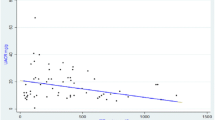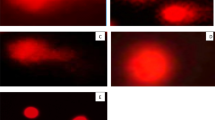Abstract
Background
Iron deficiency anemia (IDA) is the most common nutritional deficiency in the world. The aim of our study was to evaluate and compare renal functional and structural integrity in 50 infants with IDA and 50 healthy controls and to assess the relation between IDA and oxidative stress and response to iron therapy.
Methods
This was a prospective study in which peripheral blood samples were collected from all study subjects and the following laboratory investigations performed: serum iron profile, urinary microalbumin, urinary leucine aminopeptidase (LAP), fractional excretion of sodium (FeNa), serum total antioxidant capacity (TAC), serum malondialdehyde (MDA), serum and urinary trace elements (iron, copper, zinc, calcium and magnesium). All patients received oral iron therapy and were followed-up for 3 months.
Results
The levels of baseline urinary markers were higher among the patients with IDA than among the controls (p < 0.05). Patients had a lower pre-therapy TAC and lower serum zinc and magnesium levels than controls as well as higher MDA and serum copper levels (p < 0.05). MDA level was positively correlated to microalbumin and LAP level (p < 0.05). Urinary LAP concentration was positively correlated to urinary trace element concentrations (p < 0.05). A significant decrease in microalbumin, LAP, FeNa, and urinary trace elements was observed post-iron therapy while hemoglobin and ferritin levels were increased (p < 0.05).
Conclusion
Among the study subjects, IDA had an adverse influence on renal functional and structural integrity which could be reversed with iron therapy. Oxidative stress played an important role in the pathogenesis of renal injury in IDA.



Similar content being viewed by others
References
Özçay F, Derbent M, Aldemir D, Türkoğlu S, Baskın E, Özbek N, Saatçi Ü (2003) Effect of iron deficiency anemia on renal tubular function in childhood. Pediatr Nephrol 18:254–256
Monajemzadeh SM, Zarkesh MR (2009) Iron deficiency anemia in infants aged 12–15 months in Ahwaz, Iran. Indian J Pathol Microbiol 52:182–184
Reiser J, von Gersdorff G, Simons M, Schwarz K, Faul C, Giardino L, Heider T, Loos M, Mundel P (2002) Novel concepts in understanding and management of glomerular proteinuria. Nephrol Dial Transplant 17:951–955
EL-Safty IA, Afifi AM, Shouman AE, EL-Sady AK (2004) Effects of smoking and lead exposure on proximal tubular integrity among Egyptian industrial workers. Arch Med Res 35:59–65
Koyner JL, Vaidya VS, Bennett MR, Ma Q, Worcester E, Akhter SA, Raman J, Jeevanandam V, O’Connor MF, Devarajan P, Bonventre JV, Murray PT (2010) Urinary biomarkers in the clinical prognosis and early detection of acute kidney injury. Clin J Am Soc Nephrol 5:2154–2165
Basaki M, Saeb M, Nazifi S, Shamsaei HA (2012) Zinc, copper, iron, and chromium concentrations in young patients with type 2 diabetes mellitus. Biol Trace Elem Res 148:161–164
Burjonrappa SC, Miller M (2012) Role of trace elements in parenteral nutrition support of the surgical neonate. J Pediatr Surg 47:760–771
Jeejeebhoy K (2009) Zinc: an essential trace element for parenteral nutrition. Gastroenterology 137:S7–S12
Grzelak A, Kruszewski M, Macierzynska E, Piotrowski L, Pulaski L, Rychlik B, Bartosz G (2009) The effects of superoxide dismutase knockout on the oxidative stress parameters and survival of mouse erythrocytes. Cell Mol Biol Lett 14:23–34
Takami T, Sakaida I (2011) Iron regulation by hepatocytes and free radicals. J Clin Biochem Nutr 48:103–106
Samhan-Arias AK, Tyurina YY, Kagan VE (2011) Lipid antioxidants: free radical scavenging versus regulation of enzymatic lipid peroxidation. J Clin Biochem Nutr 48:91–95
Madhikarmi NL, Murthy KR (2014) Antioxidant enzymes and oxidative stress in the erythrocytes of iron deficiency anemic patients supplemented with vitamins. Iran Biomed J 18:82–87
Crawford A, Fassett RG, Coombes JS, Kunde DA, Ahuja KD, Robertson IK, Ball MJ, Geraghty DP (2011) Glutathione peroxidase, superoxide dismutase and catalase genotypes and activities and the progression of chronic kidney disease. Nephrol Dial Transplant 26:2806–2813
Ozbek E (2012) Induction of oxidative stress in kidney. Int J Nephrol 2012:465897
Suvakov S, Damjanovic T, Stefanovic A, Pekmezovic T, Savic-Radojevic A, Pljesa-Ercegovac M, Matic M, Djukic T, Coric V, Jakovljevic J, Ivanisevic J, Pljesa S, Jelic-Ivanovic Z, Mimic-Oka J, Dimkovic N, Simic T (2013) Glutathione S-transferase A1, M1, P1 and T1 null or low-activity genotypes are associated with enhanced oxidative damage among haemodialysis patients. Nephrol Dial Transplant 28:202–212
Brugnara C, Schiller B, Moran J (2006) Reticulocyte hemoglobin equivalent (Ret He) and assessment of iron-deficient states. Clin Lab Haematol 28:303–308
Miwa N, Akiba T, Kimata N, Hamaguchi Y, Arakawa Y, Tamura T, Nitta K, Tsuchiya K (2010) Usefulness of measuring reticulocyte hemoglobin equivalent in the management of haemodialysis patients with iron deficiency. Int J Lab Hematol 32:248–255
Goddard AF, James MW, McIntyre AS, Scott BB, British Society of Gastroenterology (2011) Guidelines for the management of iron deficiency anaemia. Gut 60:1309–1316
Short MW, Domagalski JE (2013) Iron deficiency anemia: evaluation and management. Am Fam Physician 87:98–104
Al Ghwass ME, Halawa EF, Sabry SM, Ahmed D (2015) Iron deficiency anemia in an Egyptian pediatric population: a cross-sectional study. Ann Afr Med 14:25–31
Elalfy MS, Hamdy AM, Abdel Maksoud SS, Abdel Megeed RI (2012) Pattern of milk feeding and family size as risk factors for iron deficiency anemia among poor Egyptian infants 6 to 24 months old. Nutr Res 32:93–99
Kabakus N, Ayar A, Yoldas TK, Ulvi H, Dogan Y, Yilmaz B, Kilic N (2002) Reversal of iron deficiency anemia-induced peripheral neuropathy by iron treatment in children with irondeficiency anemia. J Trop Pediatr 48:204–209
Hegde N, Rich MW, Gayomali C (2006) The cardiomyopathy of iron deficiency. Tex Heart Inst J 33:340–344
Walter PB, Knutson MD, Paler-Martinez A, Lee S, Xu Y, Viteri FE, Ames BN (2002) Iron deficiency and iron excess damage mitochondria and mitochondrial DNA in rats. Proc Natl Acad Sci USA 99:2264–2269
El-Safty IAM, Mohy El-Deen IE, El-Rasheed AH, El-Ashmawy MFM (2015) Renal effects of tramadol addiction and cannabinoid abuse. RJPBCS 6:1212–1218
Nakajima M, Kobayashi E, Suwazono Y, Uetani M, Oishi M, Inaba T, Kido T, Shaikh ZA, Nogawa K (2005) Excretion of urinary cadmium, copper, and zinc in cadmium-exposed and nonexposed subjects, with special reference to urinary excretion of beta2-microglobulin and metallothionein. Biol Trace Elem Res 108:17–31
EL-Safty IAM, Gadallah M, Shouman AE (2003) Effect of silica exposure on urinary excretion of copper and zinc. Am J Med Sci 326:122–127
Swaminathan S, Fonseca VA, Alam MG, Shah SV (2007) The role of iron in diabetes and its complications. Diabetes Care 30:1926–1933
Moulouel B, Houamel D, Delaby C, Tchernitchko D, Vaulont S, Letteron P, Thibaudeau O, Puy H, Gouya L, Beaumont C, Karim Z (2013) Hepcidin regulates intrarenal iron handling at the distal nephron. Kidney Int 84:756–766
El-Safty IA, Gadallah M, Shafik A, Shouman AE (2002) Effect of mercury vapour exposure on urinary excretion of calcium, zinc and copper: relationship to alterations in functional and structural integrity of the kidney. Toxicol Ind Health 18:377–388
Hebert PC, Van der Linden P, Biro G, Hu LQ (2004) Physiologic aspects of anemia. Crit Care Clin 20:187–212
Amirkhizi F, Siassi F, Minaie S, Djalali M, Rahimi M, Chamari M (2008) Assessment of lipid peroxidation and activities of erythrocyte cytoprotective enzymes in women with iron deficiency anemia. J Res Med Sci 13:248–254
Vives Corrons JL, Miguel-Garcia A, Pujades MA, Miguel-Sosa A, Cambiazzo S, Linares M, Dibarrart MT, Calvo MA (1995) Increased susceptibility of microcytic red blood cells to in vitro oxidative stress. Eur J Haematol 55:327–331
Tiwari AK, Mahdi AA, Zahra F, Chandyan S, Srivastava VK, Negi MP (2010) Evaluation of oxidative stress and antioxidant status in pregnant anemic women. Indian J Clin Biochem 25:411–418
Sundaram RC, Selvaraj N, Vijayan G, Bobby Z, Hamid A, Rattina Dasse N (2007) Increased plasma malondialdehyde and fructosamine in iron deficiency anemia: effect of treatment. Biomed Pharmacother 61:682–685
Deokar SA, Rai PSK, Bakshi AA, Rai AB (2013) Study of biochemical markers in iron deficiency anemia. Int J Res Med Sci 1:541–544
Madhikarmi NL, Murthy KR (2012) Enzymatic and non enzymatic antioxidant and lipid peroxidation status in iron deficiency. Int J Appl Biol Pharm Technol 3:130–136
Aslan M, Horoz M, Çelik H (2011) Evaluation of oxidative status in iron deficiency anemia through total antioxidant capacity using an automated method. Turk J Hematol 28:42–46
Kocyigit A, Armutcu F, Gurel A, Ermis B (2004) Alterations in plasma essential trace elements selenium, manganese, zinc, copper, and iron concentrations and the possible role of these elements on oxidative status in patients with childhood asthma. Biol Trace Elem Res 97:31–41
Kurtoglu E, Ugur A, Baltaci AK, Undar L (2003) Effect of supplementation on oxidative stress and antioxidant status in iron deficiency anemia. Biol Trace Elem Res 96:117–123
Akça H, Polat A, Koca C (2013) Determination of total oxidative stress and total antioxidant capacity before and after the treatment of iron-deficiency anemia. J Clin Lab Anal 27:227–230
Altun D, Kurekci AE, Gursel O, Hacihamdioglu DO, Kurt I, Aydin A, Ozcan O (2014) Malondialdehyde, antioxidant enzymes, and renal tubular functions in children with iron deficiency or iron-deficiency anemia. Biol Trace Elem Res 161:48–56
Financial disclosure
None.
Competing interest
None.
Contributors
All authors were involved in concept, design, data collection, analysis and drafting of the manuscript.
Author information
Authors and Affiliations
Corresponding author
Additional information
Mohamed S. El Shimi, Rania A. El-Farrash, Eman A. Ismail, Ibrahim A. El Safty, Ahmed S. Nada, Omayma A. El Gamel, Yomna M. Salem and Sara M. Shoukry contributed equally to this work.
Rights and permissions
About this article
Cite this article
El-Shimi, M.S., El-Farrash, R.A., Ismail, E.A. et al. Renal functional and structural integrity in infants with iron deficiency anemia: relation to oxidative stress and response to iron therapy. Pediatr Nephrol 30, 1835–1842 (2015). https://doi.org/10.1007/s00467-015-3122-6
Received:
Revised:
Accepted:
Published:
Issue Date:
DOI: https://doi.org/10.1007/s00467-015-3122-6




